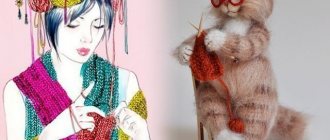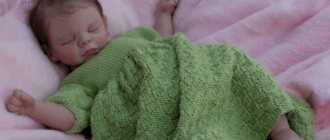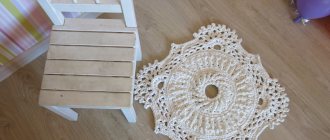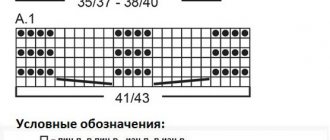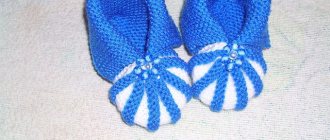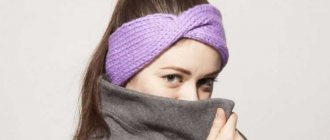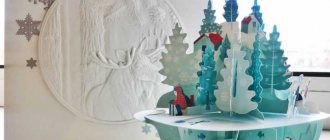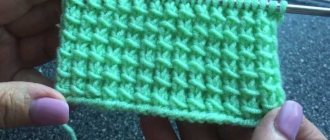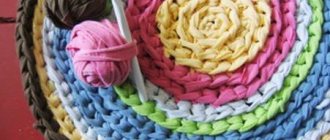Basics of Tunisian knitting techniques
The main advantage of Tunisian (Afghan) knitting is the economical consumption of threads. For example, to create a blouse or scarf you will need five times less thread than when knitting or crocheting. At the same time, the product turns out to be dense, but plastic. The Afghan knitting technique can be used to make all types of clothing, as well as blankets, pillows, and bedspreads.
Knitting for beginners
Products knitted with Tunisian weaving do not stretch. This must be taken into account when knitting clothes. Inexperienced needlewomen first need to select the appropriate tools for the job:
- Extended hook . Its length is about 20 cm. This tool is also used for Thai knitting. At one end there is a working bend, and at the other there is a limiter that will prevent the loss of loops.
- Hook with fishing line . It is used for knitting particularly wide products.
- Double hook . It consists of 2 hooks connected by fishing line. Used for cross work and circular knitting.
The working tool must be at least 2 times thicker than the working thread. Please note that a regular hook will not work for this type of needlework. The principle of the Tunisian method is to cast on stitches for each row.
Before starting work, beginning needlewomen should remember the following features of this knitting method:
- The work process occurs only on the front side of the product.
- In each odd row, a set of loops is carried out in the direction from right to left, they are knitted in the opposite direction.
- Don't tighten the loops too much.
- When casting on, it will be more convenient to hold the hook like a pen or pencil. When knitting loops, the hook should be held like a knitting needle.
- Before working on the product, you must knit a control sample.
Tool for the job
To get a product of real Tunisian knitting, you need to purchase special hooks. They differ from traditional crochet hooks in length and a stopper at the end. It is advisable to take a hook two sizes larger than for regular knitting so that the loops are less dense. For example, for a size 3.5 hook, you can buy fine cotton yarn that would normally be handled with a 1.5 hook.
The ball-shaped stop is convenient because it prevents the loops from sliding off the tool. The length of the hook depends on the width of the future product. To get a very wide blanket, you will have to sew or knit two or three panels.
There are also circular knitting needles on fishing line.
Video lesson:
Two-color Tunisian pattern
The basis of the two-color pattern is simple Tunisian columns. Diagrams describing the work are provided. A row of thread of one color is knitted onto a chain of chain stitches, and the next row is knitted with a thread of a different color. The result is columns of variable colors, and the product looks striped on the front side and quilted with dotted lines on the back side. The front side is more beautiful.
The maximum width of the product or its integral part is determined by the length of the knitting needle used, and the length can be arbitrary and depends on the number of rows cast on. If the length of the knitting needle is not enough for the entire product, it has to be made from several separate knitted fabrics.
Types of Tunisian knitting
We have studied simple knitting, and there are several more types:
- facial surface;
- twisted (the hook is inserted not from right to left, but from left to right, twisting the loop).
Facial surface
If you need the product to keep its shape, then use stockinette stitch.
Step by step:
- Let's dial in air loops. Then we will knit 2 rows using the simple Tunisian technique.
- Next, the hook must be inserted into the middle of the column from the front side under the vertical broach and pigtail. The thread must be grabbed from behind.
- Close the loops in the usual way.
- The photo shows the view from the face.
- And from the inside out.
Twisted technique
Thanks to this technique, things turn out dense, but light.
Process description:
- We will knit the first 2 rows with a simple afghan stitch.
- Twisting will begin from the 3rd row. The usual method of tying loops is repeated, only to grab them the hook should be directed from left to right. That is, we need to hook the post or, as it is called, the broach, twist, grab and pull the thread.
- This way the loops will twist. In all even rows we close the loops in the traditional way.
- At the end of the loop, it is necessary to close only after knitting the “reverse” row, having previously completed the connecting columns or single crochet for the vertical broaches.
Video lesson:
Pattern "Matting"
To begin with, a chain of chain stitches is knitted, then regular Tunisian stitches are formed. In one direction, loops are knitted, one on each basic loop, and when going back, one loop is knitted on two. This pattern is called a matting pattern and has a special designation in Tunisian knitting patterns, in the form of an inverted letter “F”, and the loop of the reverse row is indicated by a horizontal wavy line.
Beautiful dense knitting is used to create warm clothing models - sweaters, pullovers, cardigans, as well as large items that are knitted from several strips sewn together.
Afghan stitch designations
Having learned simple knitting, you can knit a variety of patterns using the following notation:
Ornaments for decorating products.
What can be knitted in Afghan technology
You can learn to make any things or jewelry. In an hour of work you will receive magnificent flowers.
By tying individual petals, after joining them, you will get a whole bouquet of flowers.
How to link:
- In the first row we close 5-7 vp into a ring.
- 2nd row. senior biological sciences, 5 v.p. – repeat 5-6 times – that’s how many leaves we need to make – we’ll get 5-6 arches.
Next, each petal is knitted under the arch:
- 1st row fastened under the first arch and knit 8 ch, turn the work
- 2nd row. 7 tbsp. b.n. (hereinafter called st.), we fasten again under the arch (we knit a blind loop under the arch and turn the work again).
- 3rd row. 8 tbsp. (we knit 2 in the last column of the previous row) turn.
- 4 row. 9 tbsp. (from the first we knit 2) the next rows also, until there are 12 in a row.
- Next we knit several rows straight. Then we begin to decrease - at the end of the petal we knit 2 tbsp. together i.e. we pull a loop from one, then from the next and knit them together, so each next row is reduced by 1 loop.
- The last row (even) should again be from 7 sts. fasten for the last time to the first arch and move on to the next petal: fasten to the next arch and again 8 ch.
The curled petals must be steamed and then collected.
Using fashionable technology, you can make no less fashionable models of cardigans, blouses, even coats.
How to knit correctly
Tunisian crochet technique
Hook
- First, you need to buy a special hook for Tunisian crochet. It should be long (up to 40 cm), without expanding or contracting areas.
- Such a hook does not have a handle, but there should be a knob at the end, just like on knitting needles. This is necessary so that the cast-on loops do not slide off the opposite side of the hook. A hook that is too long overloads the hand, so some craftswomen prefer a fishing line ending.
- The double Tunisian hook requires additional skills and additional techniques and is therefore rarely used.
- Tunisian crochet is convenient for embroidery on knitted items. Before you begin the Afghan weaving technique, it is worth mastering crochet for beginners.
Yarn
Dense weaving allows you to create a beautiful thing from almost any yarn . A thread that does not hold its shape and pattern in regular knitting behaves perfectly in this technique. Thanks to the special weaving density, the finished product does not lose shape under its own weight.
Compared to crochet, the Tunisian technique requires less material, even with a high knitting density.
Technique
Afghan knitting has several features that you need to learn before starting:
- the hook must be held the same way. like a pencil when writing;
- The finished canvas always remains facing the master during work;
- when knitting front and back rows, only the crochet technique changes, and not the position of the finished fabric;
- the hook is threaded only through the vertical loops of the previous row - this way you will get a uniform pattern;
- Closing the work is carried out in the front row when knitting loops from right to left.
This is what the execution of a simple fragment looks like in the diagram.
The result of knitting you will get a fillet mesh, the knitting patterns of which are often used when creating crocheted tablecloths, blankets and napkins.
The mesh can be straight - when the hook in the next row is inserted into the top of the column.
A checkerboard fillet mesh is obtained by inserting a hook into the gap between the posts of the previous row.
Detailed crochet patterns with symbols will help you understand the pattern before you start working with threads.
Tunisian Crochet Patterns
Tunisian crochet can create high-quality fabric and a beautiful combination of shades. But airy openwork patterns are beyond his strength. So you can show your imagination and combine several knitting techniques.
Let's look at the basic patterns of front and back weaving.
When knitting, the hook is inserted into the previous knitted row, while the working thread is on the fabric.
In purl weaving, the thread is passed in front of the fabric and a kind of yarn is made from the working thread, as shown in the diagram.
Colored rows are achieved by a simple technique: knitting the fabric in one direction is done in one color, and in the other direction in a different color. To avoid cutting the thread on each turn, prepare several balls of the same color and arrange them according to the pattern.
Decorative flowers in Tunisian crochet
Using this technique, you can knit not only rectangular, but also rounded parts. The round center of a daisy or other flower is crocheted using the same crochet pattern, which can be used to create napkins of different sizes.
Flower petals are created according to a pattern that partially resembles the middle. Only the rounding goes along one edge, as shown in the diagram.
The finished parts are fastened together with colored thread and decorated with beads, rhinestones or lace.
See what beautiful decorations you can get using simple patterns.
— Crocheted flowers have many uses in both decorative and applied knitting.
Knitting a blanket with Tunisian crochet
Hand-knitted blankets are very popular today. Crocheted or knitted - they are only in demand and presented as a gift, but they are also very expensive.
Many women are hesitant to start such global work, fearing that it will take up all their free time. But the Tunisian technique will help you knit a beautiful blanket using the patchwork technique. Small multi-colored squares need to be connected in a special way to create one common canvas.
How to connect the squares to each other can be seen in the diagram.
Sometimes you want some variety from strict forms. And then triangles come to the rescue, which can be connected into elaborate patterns. How to decrease stitches so that you get a perfect edge can be seen in the diagram.
The resulting triangle must be supplemented with yarn of a contrasting color until it is a complete square.
The knitting pattern itself is simple. More attention needs to be paid to the correct connection of individual fragments.
— Crocheted dolls, created by mother’s hands, will definitely please your baby.
Tunisian crochet snood or scarf
When you want to immediately put the acquired skills into practice, there is simply no better idea to start with than knitting a scarf or snood.
Simple shapes and original shades will help you create a fashionable accessory that will also warm you up in cold weather.
Patterns that combine simple techniques with different shades of yarn look beautiful. Look at the photos of the finished works and choose the most beautiful combination of threads for yourself.
